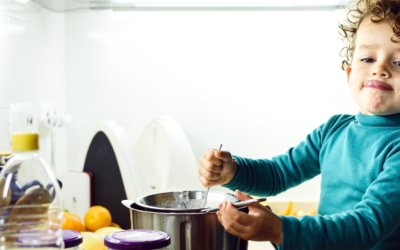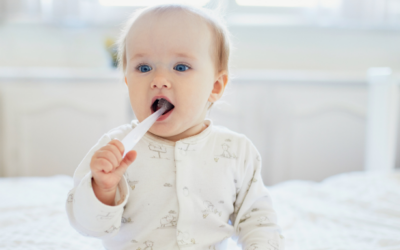Introducing your baby to solid foods begins when they’re around 6 months of age, and for some parents, it’s a milestone they can’t wait to reach! Mealtimes can be lots of fun – as you watch your baby exploring different tastes and textures, discovering his or her favourite foods, and (more often than not) getting a lot of ‘messy play’ time into the bargain as well!
But weaning is a big topic and one that can also cause some confusion and stress for parents. Especially if it’s their first time around. In this article, we’ll take a look at some of the different approaches to starting your baby on solid foods, as well as sharing Team Happity’s top tips.
“One thing I would definitely recommend is doing a baby first aid course. Choking was a huge fear of mine, and so having done a course made me feel more prepared for what I would do in a worst case scenario.”
Alex, Happity Customer Happiness Angel
When Should I Start Weaning?

But first, how do you know your baby is ready to start on solid food? According to the NHS website, your little one should be:
- Around 6 months or older
- Able to stay in a sitting position, holding their head steady (this helps them swallow their food safely)
- Able to coordinate their eyes, hands and mouth, so they can pick up food and eat it themselves
- Able to swallow the food that goes into their mouth, rather than pushing it straight back out with their tongue (although this one might take a bit of practice!)
It’s worth remembering that it’s totally normal for babies to gag on their food as they are getting started with weaning – even if the noises can be a little alarming!
“We let Lyra play with her weaning spoons before we introduced any food, so they weren’t completely foreign objects when we did start.”
Helen, Happity Growth Marketing Assistant
Should I Do Baby-Led Weaning, Or Offer Purees?

So, what’s the best way to start introducing solid foods to your baby? If you’ve been researching the topic, you might have heard about Baby Led Weaning (BLW). This is where you introduce finger foods right from the beginning of the weaning journey, and allow your baby to explore and self-feed, rather than offering puree or mashed food on a spoon.
Proponents of baby-led weaning will point to all sorts of benefits: saying it improves hand-eye coordination, reduces fussy eating, and boosts baby’s confidence in their own abilities. Plus, if you go for a baby-led approach, you won’t have to worry about pureeing or mashing foods. Instead, you’ll be preparing a single meal for the whole family. Which can be a massive bonus for those evenings when getting one dinner together feels hard enough! (Just make sure to watch the salt on your baby’s portion. Babies should not have salt or sugar added to their food, and many packaged or processed foods contain surprisingly high levels of both.)
“We did baby-led weaning with both our two. They say that BLW helps kids develop a love of food, and makes them less picky, and that certainly seems to have worked for us.” –
Gayle, Happity Partnerships Marketing Assistant
But there’s no denying that baby-led weaning can be MESSY, and – for some parents – can add to nervousness around choking. If you decide to start with spoon feeding, you may want to begin with smooth pureed food, before moving onto lumpier textures.
“I did find there was a lot of pressure to do baby-led weaning rather than spoon feed, as if spoon feeding was somehow lazy. Not great when you’re shattered and trying to keep yourself and your baby going. Sometimes you just need an Ella’s Kitchen pouch!”
– Becky, Happity Coding Alchemist
It’s also totally fine to mix and match your techniques depending on your family’s needs – offering spoon foods at some meals and self-feeding at others, or having a mixture of spoon and finger foods within each meal. As with most aspects of parenting, it’s best not to have too many fixed plans about how things will go, as your baby will likely have his or her own ideas too! Going with the flow and experimenting will make mealtimes a lot more fun for the whole family.
“I was very single-minded about baby led weaning with Lucy (my eldest), I remember getting quite cross with my mum for spoon feeding her! But with my second, I was much more flexible. There was no way I was going to get Oliver cleaned up after a bowl of self-fed porridge every morning, and still get my daughter to school on time! So he would usually have a spoon-fed breakfast, and then at tea-time he would feed himself, giving me more space to chat and interact with both children.”
– Lisa, Happity Head of Marketing.
“There’s no need to rigidly follow one path vs the other. I would often do a purée or spoon feed an evening meal when we were short on time.”
Sara, Happity co-founder
What Are Good First Foods For Babies?
If you’re offering finger foods, you’ll want to start with shapes your baby can easily grab and hold in a fist. This includes Broccoli and cauliflower florets, cucumber sticks, toast fingers, cheese sticks, cooked giant penne and miniature rice cakes. These are all great foods your baby could try as he or she is getting to grips with self-feeding.
For purees, you can try blending different varieties of vegetables. For example; courgette, pea and kale; broccoli and sweet potato; or spinach and roasted carrots. Some research suggests that it’s a good idea to make sure more sour and bitter-tasting vegetables are in your baby’s diet right from the beginning. Introducing them early will make the baby more receptive to these flavours later on.
“We started with veg rather than fruit (after baby rice) as I was told this would reduce the chances of a sweet tooth. I’m inclined to say this worked, as Oliver LOVED veg, and still does, and tends to eat sweet things in moderation. He’s never had any teeth issues either.”
Emily – Happity co-founder
What Foods Should I Avoid For My Baby?
The NHS advises parents to avoid the following foods for their babies:
- Added salt and sugar
- Foods high in saturated fat, like crisps, biscuits and cakes
- Honey (until they are over 1 year old)
- Whole nuts
- Mould-ripened cheeses like brie and camembert, blue-veined cheese such as Roquefort, or ripened goats’ milk cheese.
- Uncooked eggs – unless these are stamped as ‘British Lion Quality’
- Rice drinks
- Raw jelly cubes
- Raw shellfish, shark, swordfish and marlin
Ready To Start Your Baby On Solid Foods?
We hope this guide has been useful as you prepare to start weaning your baby. It should hopefully help you to feel a little more confident if the whole topic made you nervous! Remember, your baby will get most of the nutrients they need from breastmilk or formula until they’re 1, so don’t worry about how much they are eating in the beginning. Instead, relax, keep trying different foods, and enjoy this exciting new stage in your baby’s development! Good luck!

Want to get out and about, have fun with your baby or toddler, and meet other parents?
Search Happity to find everything that’s happening for the under-5’s in your local area – from music and singing classes, to messy play, arts and crafts, baby massage, gymnastics and more. Simply enter your postcode and child’s age to search, and then book your spot in a few taps. Enjoy dedicated fun time with your little one, watch their skills develop, and make friends at the same time. Mums, dads, grandparents and carers will all find something to love!
If You Found This Post Useful, You May Also Like:
5 Necessary Features To Think About When Buying Your First Highchair
Bless You! Everything You Need To Know About Your Baby’s First Cold






0 Comments